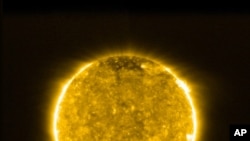Officials from the European Space Agency, ESA, and its U.S. counterpart, NASA Thursday released the first ever pictures from the agencies’ joint Solar Orbiter mission, including the closest pictures ever taken of the sun.
The orbiter was about 77 million kilometers from the sun - about halfway between Earth and the star - when it took the stunning high-resolution pictures last month.
During a remote news briefing as the pictures were released, ESA’s Solar Orbiter project scientist, Daniel Müller, said the mission was off to an excellent start. He said, “We didn’t expect such great results so early.”
The Belgium Royal Observatory’s David Berghmans, the principal investigator for the “Extreme Ultraviolet Imagers” (EUI) on board the spacecraft, described the very first high-resolution image they saw from the orbiter, which snapped a picture of the sun’s corona, or outer disc. He said they did not expect to see much - the region of the sun is known as the “quiet corona” for that reason.
But he said the pictures revealed activity they did not expect. “We couldn't believe this when we first saw this and we started giving it crazy names like ‘campfires’ and ‘dark fibrils’ and 'ghosts' and whatever we saw.” He said there was so much they had to start “a new vocabulary” to give names to all the new phenomena they saw.
The solar orbiter was launched Feb. 9 from the Kennedy Space Center on Florida's Cape Canaveral. The mission is designed to provide first-ever close-up views of the sun's polar regions and observe its magnetic activity.
The research could answer decades-old burning questions about the inner workings of our nearest star.







